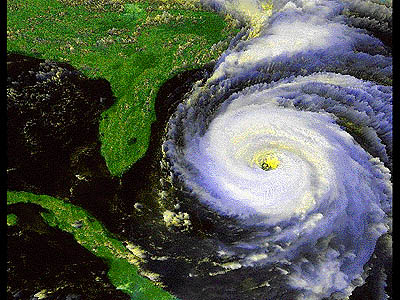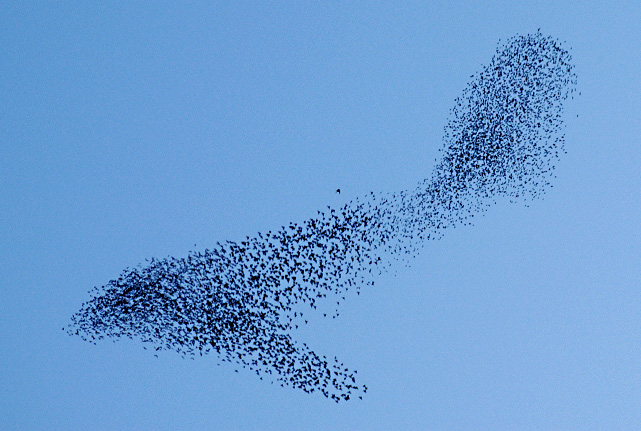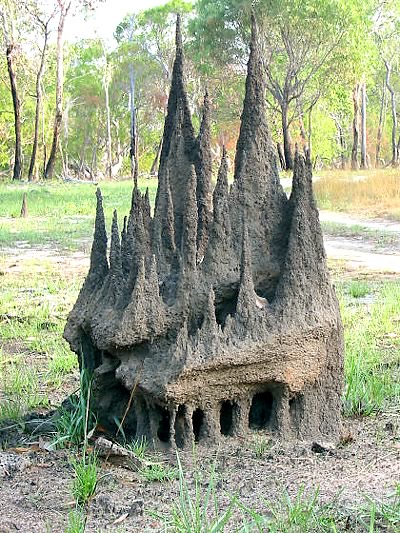Example Emergent Phenomena
Nature offers many familiar examples of emergence, and humans have created many more.
The following examples of emergent systems illustrate the kinds of feedback between individual elements of natural systems that give rise to surprising ordered behavior. They also illustrate a clear trade-off between the number of elements involved in the emergent system and the complexity of their individual interactions. The more complex the interactions between elements, the fewer elements are needed for a higher-level phenomenon to emerge. Hurricanes and sand dunes form from vast numbers of very simple elements whereas even small groups of birds can exhibit flocking behavior.
What is the lesson for multicellular computing? It is that networks of computers support many sorts of emergent meta-level behavior because computers interact in far more complex ways than air and water molecules or particles of sand. Some of this emergent behavior in computing contexts is desirable and/or intentional, and some (bugs, computer viruses, dangerous botnets, and cyber-warfare) are not.
It behooves us to better understand emergence in complex dynamic systems.
Hurricanes

Hurricanes emerge from mutual positive feedback between wind, humidity, evaporation of sufficiently warm ocean surface waters and Coriolis effects.
Two phenomena, linked in a feedback loop, provide the sustained energy that allows wind speeds to grow and the hurricane to organize. One is that the rate of surface evaporation depends upon surface wind speed and water temperature. The faster the wind and the warmer the surface water, the more water evaporates and is captured by the wind. The other phenomena is that as humid air rises it cools, causing water vapor to condense, which releases the heat required to evaporate the water in the first place. The added heat warms the surrounding air and causes it to rise faster. The resulting updraft draws more humid air from below which in turn condenses and further fuels the positive feedback cycle.
By themselves, the evaporation/condensation processes do not necessarily cause hurricanes. The same processes at smaller scale fuel thunderstorms. To become a hurricane, tirst the wind pattern has to organize into the familiar spiral. The spiral winds allow the process to gather energy from a large swath of warm ocean and concentrate it into a central region where maximal winds can be generated. The spiral organization is caused by Coriolis forces which, in the northern hemisphere, cause rising air (gradually) to tend toward a counterclockwise spiral. The Coriolis effect is very weak. It takes days of favorable conditions and thousands of square miles of ocean for a well organized spiral to emerge from what otherwise would simply be a bunch of tropical thunderstorms.
The lesson is that you can't have a tempest (hurricane) in a teacup. Scale matters!
Sand Dunes
 Sand dunes result from
feedback between prevailing winds that blow grains of sand along
the surface and the effect that a ripple in the sand surface has
on the flow of the wind over it. When the sand surface is flat,
grains of sand blown by the wind land in no particular pattern.
But any obstruction -- a rock, a fence post, even an ant hill --
that disrupts the smooth flow of the wind causes sand to land
preferentially in the "wind shadow" behind the obstruction. This
new sand adds to the disruption of the wind flow which, in turn,
causes even more sand to collect on the downwind side. High
winds on a beach create small ripples in sand. Large dunes
require miles of sand, e.g., in Death Valley, Calif. the
Huacachina dunes on the coast of Peru, or in the "Empty Quarter"
in Saudi Arabia.
Sand dunes result from
feedback between prevailing winds that blow grains of sand along
the surface and the effect that a ripple in the sand surface has
on the flow of the wind over it. When the sand surface is flat,
grains of sand blown by the wind land in no particular pattern.
But any obstruction -- a rock, a fence post, even an ant hill --
that disrupts the smooth flow of the wind causes sand to land
preferentially in the "wind shadow" behind the obstruction. This
new sand adds to the disruption of the wind flow which, in turn,
causes even more sand to collect on the downwind side. High
winds on a beach create small ripples in sand. Large dunes
require miles of sand, e.g., in Death Valley, Calif. the
Huacachina dunes on the coast of Peru, or in the "Empty Quarter"
in Saudi Arabia.
The shapes of dunes are dictated primarily by prevailing wind direction. When prevailing winds are nearly always from the same direction, dunes tend to form in rows. When the winds are more erratic, you may see much more complexly shaped dunes as in the above photo of what are called "star" dunes.
Sand dunes emerge at a scale intermediate between hurricanes
and flocks of birds. Interactions between grains of sand and
surface winds are much more complex than interactions between
the far more numerous air and water molecules in hurricanes, yet
grains of sand interact far more simply than birds in a flock.
Flocks of birds

In a flock of starlings, the behavior of the flock emerges from the desire of the individual birds to avoid collisions while staying close to neighbors. Positive feedback occurs because the behavior of each bird affects its neighbors and vice versa. Craig Reynolds' boids simulations show similar behavior. Two researchers have proposed possible relationships between boid-like swarming behavior and aspects of multicellular organisms. See Boids Model Applied to Cell Segregation and J. Rothermich's masters thesis
Flocks of starlings involve hundreds, perhaps thousands, of birds. But you can observe clear flocking behavior from a couple of dozen starlings or four or five pelicans. Even the largest flocks of starlings -- reportedly 5000 birds or so -- are many orders of magnitude less numerous than the elements involved in hurricanes or sand dunes. There are billions of sand grains in just the top millimeter of a large sand dune and orders of magnitude more air and water molecules in a hurricane than grains of sand in the Sahara. Yet the interactions between just two birds is incomparably more complex than interactions between two sand grains or air molecules.
Termite Mounds

Termite mounds appear to be constructed by "intelligent" cooperation. The sometimes elaborate galleries and chimneys control air flow to manage temperature and humidity inside the nest. But individual termites have no more notion of how to build a nest than a starling does of how to lead a flock. Individual termites cannot even perceive the overall shape of a nest (the workers are blind) let alone direct its "design."
Instead, termites respond to very local chemical cues left behind by other termites and to temperature/humidity and airflow cues that are affected by the shape of the nest, wind currents, the amount of heat generated within the nest and other local phenomena. The termite's behavior affects the shape of the nest and the shape of the nest affects the termite's behavior. In that sense, the nest is a bit like a flock of starlings in very slow motion.
Flocks of birds and hurricanes
are real-time dynamic phenomena with no lasting structure. But
much emergent behavior is mediated by persistent changes to the
local environment.
Sand dunes and termite mounds are persistent physical
structures that organize the behavior of the very entities that build them.
That is, emergence often gives rise to
stigmergy structures.
Stigmergy structures are
emerging in he Internet too, based on persistent structures such as
databases, wikis, and blogs.
Stigmergy is one of the four
multicellular architectural principles that are the focus
of this web site.
Last revised 3/13/2015